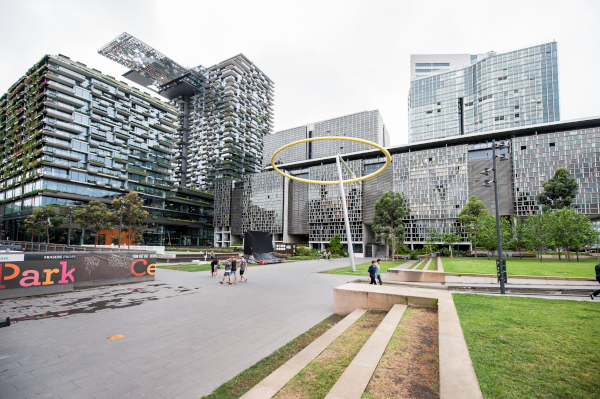This is primarily because in the past the built environment – the man-made elements of our surroundings such as buildings and infrastructure – has been designed around the linear ‘take-make-dispose’ model, in which materials are sourced, used and subsequently disposed of as waste.
A question we are now asking ourselves is how can we commit to reaching sustainable development goals, whilst working in an industry heavily relying upon the use of natural resources to construct new buildings and infrastructure?
According to the Global Resources Outlook, the demand for natural resources has rapidly increased over the past 50 years, with global extraction reaching 92 billion tonnes per annum. More concerningly, approximately 50% of these resources are used for building materials.
Within Australia, the National Waste Policy estimates that we produce 67 million tonnes of waste per annum, of which 60% is generated by commercial, construction and demolition activities.
On top of that, the construction, operation, and maintenance of buildings across Australia comprises approximately one quarter of our total greenhouse gas emissions.
From these figures, it is evident that we must create significant change to stop the devastating environmental, social, and economic impacts that the built environment can have.
So, what are the solutions?
If these figures concern you as much as they concern us then you too are probably wondering well, what can our industry do about it?
Whilst there is certainly no one-fix-all solution, the good news is that our industry has already started to innovate how we can reduce and improve our environmental impact, particularly through the utilisation of sustainable materials and restoration of biodiversity in new developments.
The Circular Economy
In comparison to the current linear model, the circular economy is an innovative and regenerative model for rethinking our approach to production by reducing our consumption of resources and subsequent waste.
According to Planet Ark, the three principles of a circular economy are underpinned by a transition to renewable energy sources. This includes:
- Designing out waste and pollution
- Keeping products and materials in use
- Regenerating natural systems
By applying these key principles to the built environment, we can create an industry that relies more heavily upon recycled materials, maintains natural ecosystems, and creates urban areas that are more liveable for our communities.
One such example of how these principles can be applied, is the work of Centre of Sustainable Materials Research & Technology (SMaRT) at the University of NSW.
Led by Professor Veena Sahajwalla, SMaRT works with industry, national and international research partners and governments across Australia to develop innovative environmental solutions for our biggest waste challenges.
The SMaRT Centre has developed MICROfactorie technologies to transform waste materials, such as glass, textiles and plastics, into new materials and products, such as engineered green ceramics for the built environment.
These green ceramics have already been incorporated into Mirvac’s Marrick & Co. apartment project in Sydney, which demonstrates how extending the life of the materials we use can have a variety of economic, social and environmental benefits.
Green Rating Systems
Green building rating or certification systems help to mitigate the impacts of the built environment through measuring, encouraging and recognising sustainable development practices.
Two examples of Australian green rating systems include Green Star, developed by the Green Building Council of Australia and EnviroDevelopment, created by the Urban Institute of Australia.
Green Star is an internationally recognised sustainability rating and certification system for buildings, fitouts, and communities. Through a robust, transparent and independent assessment process, Green Star aims to transform the built environment by:
- Reducing the impact of climate change
- Restoring and protecting biodiversity and ecosystems
- Enhancing our health and quality of life
- Driving resilient outcomes for buildings, fitouts and communities
- Contributing to market transformation and a sustainable economy
Similarly, EnviroDevelopment is a scientifically based independent rating system that recognises developments that have satisfied a high standard of sustainability requirements from concept through to completion.
These certifications are determined through six key factors – ecosystems, waste, water, energy, community engagement, and materials.
Barker Ryan Stewart is a corporate member and proud supporter of the Urban Development Institute of Australia’s (UDIA) EnviroDevelopment Professional program.

Making our Built Environment Green
It is undeniable that creating greener spaces is an integral part of any sustainable built environment.
One such way this is achieved is through the inclusion of green roofs and walls, which are used globally as an important climate change adaption tool.
With less ground-level space available in cities for parks, gardens and trees, the inclusion of engineered forms of green infrastructure including green roofs, walls and facades creates opportunities to grow plants up and on top of built structures.
There are a broad variety of environmental, social, and cultural benefits associated with the inclusion of green roofs and walls in urban development. Some of these benefits include:
- Improved air quality
- Increased biodiversity
- Increasing the absorption of carbon dioxide
- Insulating buildings from heat and noise
- Improving the efficiency of solar panels
- Cooling city temperatures and reducing the impacts of urban heat island
- Slowing and cleaning stormwater runoffs
- Extending roof life
Whilst Australian cities are currently lagging behind many international counterparts in creating greener spaces, the newly released roadmap for green roofs, walls and facades in Australia’s urban landscapes 2020-2030 sets out how we can create a greener, more liveable built environment.
Our Commitment
Whilst the built environment currently depends on new materials for its growth, it is evident that our industry has begun to innovate and develop new ways in which we can create sustainable change.
At Barker Ryan Stewart, we are fully committed to delivering environmentally sustainable outcomes to help our communities prosper and grow. We support the United Nations Sustainable Development goals, we are working towards becoming a BCorp certified company, and we will be releasing our Sustainability Report shortly which will outline our commitment to and how we will reach our sustainability targets.
